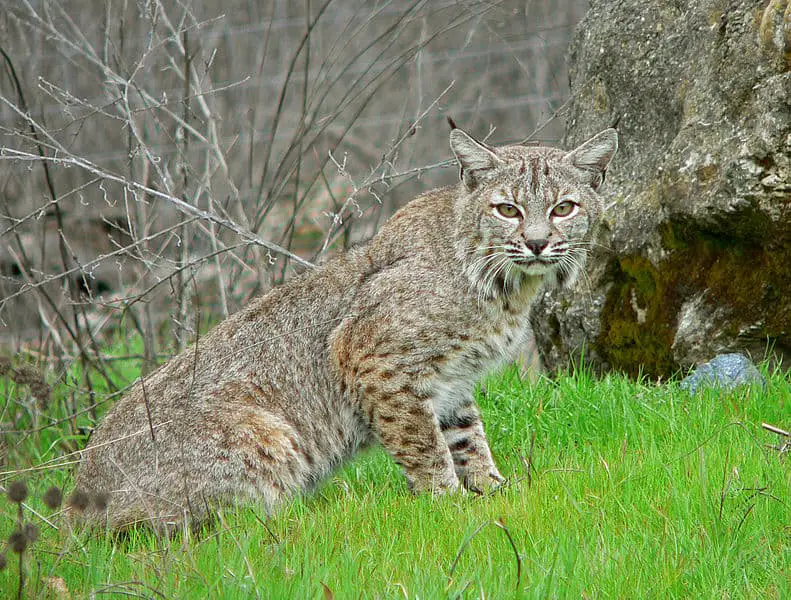The state of Kentucky has two native wild cats. These are the bobcat, (Lynx rufus) and the mountain lion, (Puma concolor).
According to the Kentucky Department of Fish & Wildlife Resources website, bobcats in Kentucky went through a period of scarcity. They were considered rare as recently as 1974. However, today their population is either stable or on the increase throughout the state, and there are bobcats in all 120 of its counties. When we talk about Kentucky wildcats, we’re either talking about bobcats or the University of Kentucky’s mascot.
On the other hand, mountain lions have been extirpated from Kentucky since before the civil war. There are occasional occurrences of these big cats within the state but no evidence of a breeding population.
We’ll talk more about the bobcat and the mountain lion in Kentucky, plus the possibility of black panther sightings in Kentucky, in the paragraphs below.
Also see
Bobcats in Kentucky (Lynx rufus)
The bobcat, which is also known as the red lynx, the bay lynx, or the swamp tiger, is a North American wild cat. Biologists believe that both the bobcat and the Canada lynx are descendants of the Eurasian lynx whose ancestors crossed into North America via the Bearing Sea land bridge.
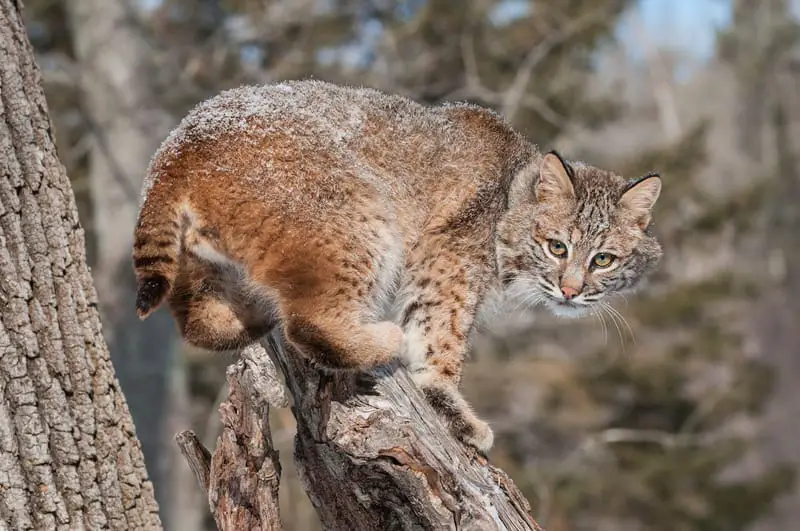
What do bobcats look like?
Adult bobcats are similar to their close relative, the Canadian lynx, in appearance, with some differences. An Adult bobcat is slightly smaller than an adult Canada lynx.
Compared to Canadian lynx, which thrive in deep snow country, bobcats struggle more in the snow due to the fact that they cannot walk on top of it as lynx can. A lynx’s large paws function like snowshoes keeping it on the snow’s surface. They have evolved this characteristic to hunt snowshoe hares in the winter. On the other hand, compared to lynx, bobcats have small feet that tend to sink into the snow. If the snow is too deep and powdery, it reduces their mobility along with their ability to catch prey.
A bobcat is roughly twice the size of an average house cat. They are 2 to 3 feet long and weigh 15 to 35 pounds. Adult male bobcats are around 33% larger than female bobcats.
These animals have “bobbed,” short tails with black tips and bold black bars on the upper surface. The black tip on their tail is only on its upper surface but not the back. As opposed to a lynx’s tail which looks like it was dipped in black paint.
Their fur is usually gray to brown, with mottled dark spots that range from black to dark brown on their bodies. “A note on this is that in the eastern U.S., bobcats have fewer spots on their bodies than bobcats in the west do.” They also have black stripes on their inner forelegs and tail.
From a side view, you will notice that a bobcat is slightly higher at the rump than at the shoulders. Bobcats and lynx have long hind legs in proportion to their forelegs.
Bobcats have black-tufted ears. In other words, they have short tufts of black hair that poke up above their ears that are black at the tips. The backs of their ears, below the black tips, are black. Additionally, they have white spots on the back of each ear. This gives the impression of a false eye on the back of each ear.
They also have a whiskered face that seems broader due to their prominent face ruff and whiskers. Their eyes are yellow with round black pupils.
In 2020, film footage of a rare black bobcat was taken near Danville, Vermont. See. These melanistic bobcats have all the markings that non-melanistic ones do. They manifest as darker black spots on top of lighter black or dark grey.
Where do bobcats live?
Bobcats reside only in parts of North America. They’re also the most common wild cat in North America. Their range begins in southern Canada and then extends south through most of the continental United States and down into central Mexico.
Bobcat sightings are rare because they are shy creatures and mostly a nocturnal or crepuscular animal. Your best chances of spotting one are in the early morning and early evening hours.
A Bobcat is generally a solitary animal. The exceptions to this generality are during breeding season and when a female is raising young. They are territorial and live in a home range that they patrol and scent mark with urine gland secretions, feces, and claw marks.
The size of their home ranges varies with the geography and the availability of prey. Male bobcat home ranges are generally larger than female bobcat home ranges.
It’s also important to note that while female home ranges do not overlap, a male bobcat’s home range might overlap with the home ranges of several female bobcats.
Other than their inability to cope with deep snow, bobcats are pretty versatile and tend to utilize all the different varied types within their range. Look for signs of wild bobcats in any rugged wooded area. They inhabit many types of habitat, such as rocky outcrops, hardwood forests, swamps, bogs, and brushy areas. Less frequently, they exist in areas adjacent to agricultural land, and suburban areas. They also seem to thrive in wooded areas in close proximity to clear cuts. Studies show that small mammal populations increase in clear-cut areas. This is due to the improved food and cover conditions that a clear-cut creates. See
In urban surroundings, it’s not unheard of for a bobcat to stake out someone’s backyard bird feeder.
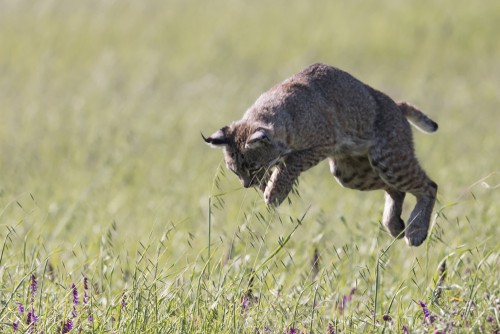
What do bobcats eat?
Despite being smaller animals, bobcats are aggressive, tough predators. They are the personification of opportunistic feeders. They prey on a wide variety of wild animals. At times, particularly during the winter, they take larger animals that are quite a bit bigger than they are, such as deer. In Kentucky, for instance, they sometimes prey on white-tailed deer.
However, their regular diets mainly consist of small mammals such as mice, rats, voles, rabbits, squirrels, muskrats, opossum, and beaver. They also feed on birds, insects, amphibians and reptiles, and carrion. When they take up residence close to residential or rural areas, their menu might occasionally also include domestic pets, small farm animals, and poultry.
Bobcats even use venomous snakes as food sources when the opportunity arises despite not being immune to the venom. They accomplish this by using their quickness to pin the snake’s head down with a paw, after which they dispatch the snake with a quick bite to its spine behind the head with their sharp teeth.
Kentucky is home to 4 venomous snakes. these are the Timber Rattlesnake (Crotalus horridus), the Western Pygmy Rattlesnake, (Sistrurus miliarius streckeri), the Eastern Copperhead, (Agkistrodon Contortrix), and the Western Cottonmouth, (Agkistrodon piscivorus) See
Reproduction and Life Cycle for Bobcats
Mating season for bobcats occurs between January and April. Bobcats are polygamous. This means that a male bobcat may mate with multiple females.
If they successfully mate, the gestation period for bobcats is 60 days.
After breeding, the male and female go their separate ways. Other than in the exceptions of breeding and raising young, they’re solitary animals.
The female takes all responsibility for the selection of a den site and the rearing of the young.
Bobcats often use rock crevices as den sites but may also den in hollow logs, or the cavity beneath an overturned stump or beneath a blown-down tree,
In Kentucky, the bobcat litter size ranges from 1 to 7 kittens, but most contain 2-3.
Bobcat kittens are born with their eyes sealed, just like domestic cats are. However, their eyes will open when they are a week to 10 days old. By the time they are 2 months of age, they will have replaced their spotted baby fur with a haircoat similar to what their parents have.
By mid-July, the kittens begin to venture out with their mothers to fine-tune their survival skills. Their training may last into the early winter. By mid-winter, the kittens strike out on their own.
Female bobcats reach sexual maturity at 1 year of age, while males reach sexual maturity at age 2.
Bobcats live 7 to 10 years on average in Kentucky. The oldest bobcat found in Kentucky was 16 years old, while the oldest one in the United States was 23. See
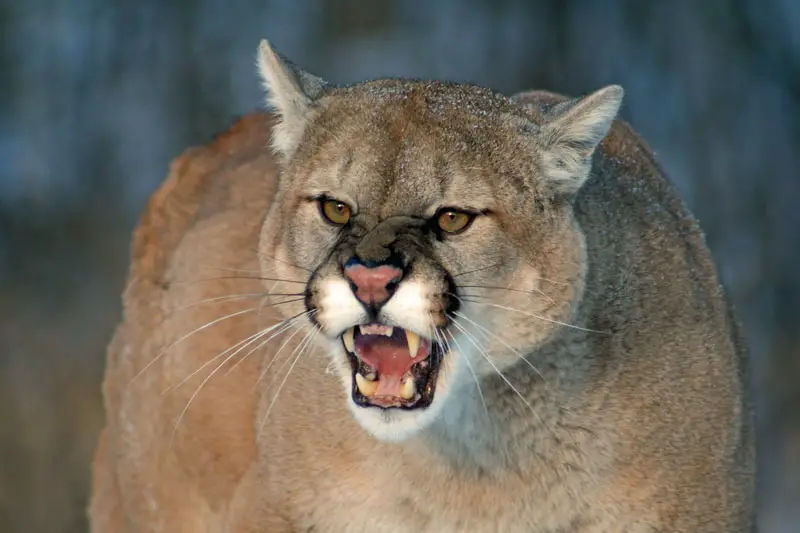
Are there mountain lions in Kentucky?
Due to the fact that they live over a wide geographical area, this large cat has a long list of regional names. In recent years, their scientific name was even changed from Felis concolor to Puma concolor. Some common names that mountain lions go by are cougar, panther painter, Andean Mountain lion, and puma.
The eastern subspecies of cougar is a native species to Kentucky. However, these large felines have not been present in the state since the late 1800s.
Again quoting the Kentucky Fish & Wildlife website, “In the landmark 1974 book “Mammals of Kentucky,” authors Roger W. Barbour and Wayne H. Davis noted there were no valid records of mountain lions in the state after 1899.”
Additionally, the U.S. Fish and Wildlife Service declared the eastern cougar sub-species to be extinct in 2011. To add some confusion to the subject, researchers have compared mitochondrial DNA from eastern mountain lion specimens to that of western mountain lions and determined that the eastern mountain lions sampled are not any more closely related to each other than they are to the western mountain lions. See. This calls into question whether not eastern cougars ever existed as a distinct sub-species.
One more wrinkle to the question of the eastern cougar is this. Wildlife experts now have all mountain lions grouped into sub-species. As of the year 2017, mountain lions are taxonomically divided into 2 sub-species. The first is (Puma concolor couguar) or northern cougar. Northern cougars range through North America, Central America, and possibly northwestern South America. The second sub-species is (Puma concolor concolor) or southern cougar. These cats range only in South America See
Where are mountain lions typically found?
Mountain lions live on all three of the American continents. Their range begins in Canada’s Yukon territory and extends south through parts of North America, Central America, and South America to the southern tip of Argentina.
In Canada, the biggest populations of them are in British Columbia and Alberta. On the other hand, in the United States, they mainly live in the western United States, South Dakota, Nebraska, and Florida in the southeast. In Florida, the cougar is called the Florida Panther.
Mountain lion sightings are on the increase in the Bluegrass state. However, according to Kentucky Fish & Wildlife officials, the vast majority of these are cases of mistaken identity. Here’s a quote from their website. “The increasing number of big cat reports in the state coincides with the return of the bobcat to Kentucky’s landscape.”
There have only been 2 confirmed mountain lion sightings in Kentucky within the last 25 years. The first one was a female kitten that was struck and killed by a vehicle in Floyd County in 1997. DNA testing indicated that it was of South American origin. This means it was likely an escaped pet. The second mountain lion incident in Kentucky occurred in 2014 when a Kentucky Fish and Wildlife conservation office shot and killed a male mountain lion in Bourbon County. Mark Marraccini, who is the information officer at the Kentucky Department of Fish and Wildlife, says the Bourbon County cougar looked too well fed to have traveled 100s of miles from an established mountain lion population. It is likely that it, too, was a released or escaped pet.
The closest known wild population of mountain lions to Kentucky is in Nebraska.
It’s conceivable that mountain lions occasionally visit Kentucky. Young males sometimes travel 100s of miles from established breeding populations as they seek to establish their own territories free from dominant males.
A famous case of this occurred in 2011 when a young cougar traveled 100s of miles from South Dakota to be struck and killed by a vehicle in Connecticut. See
What do mountain lions look like?
To visualize what a mountain lion looks like, picture a giant house cat with short tan hair. Mountain lions are much larger than domestic cats, though. Average house cats weigh in at around 10 pounds, while an adult male mountain lion can weigh over 200 pounds.
These large cats have muscular slender bodies, rounded heads, and upright ears that are oval at the tip. Another characteristic that mountain lions have is their muscular long tails, which account for almost one-third of the entire length of the animal. They use their long tail for a counterbalance, moving it from side to side as they navigate through uneven terrain.
Mountain lions have a tan coat of short, coarse hair over most of their body. The area around their nose, the tip of their tail, and the tips of their ears are black. Their belly fur, their inner legs, the area above their upper lip, below their lower lip, and their chin are all white. They also have a sprinkling of dark hair on their backs. There are some coat color variances between different geographic locations.
Mountain lions are the second largest cat in the Western hemisphere, smaller only than the Jaguar. However, worldwide, the African Lion and the Tiger are also larger.
Male and female mountain lions are phenotypically identical in every respect except for size. Males are 30 to 40% bigger than females. Though sizes vary considerably throughout the cat’s geographic range, an adult male cougar typically weighs between 110 and 180 pounds, 50 to (82 kgs). A rare few of them grow bigger than 200 pounds (91kgs). Female mountain lions or queens average between 80 and 130 pounds (36 to 59 kgs). Adult males or toms will reach a length of 6 to 8 feet (1.8 to 2.4 M) from their snout to the tip of their tail. On the other hand, adult females are 5 to 7 feet long (1.5 to 2.1 M).
Mountain lions are not big cats
A fun fact is that despite their large size, mountain lions are not taxonomically classified as big cats because they cannot roar. Leopards, for example, are smaller than mountain lions, but since they can roar and cannot purr, they are classified as big cats, while mountain lions are not. Another interesting thing that I can mention here is that mountain lions purr.
Since they purr and cannot roar, mountain lions are in the Felis genus, while big cats that cannot purr and can roar are in the Panthera genus.
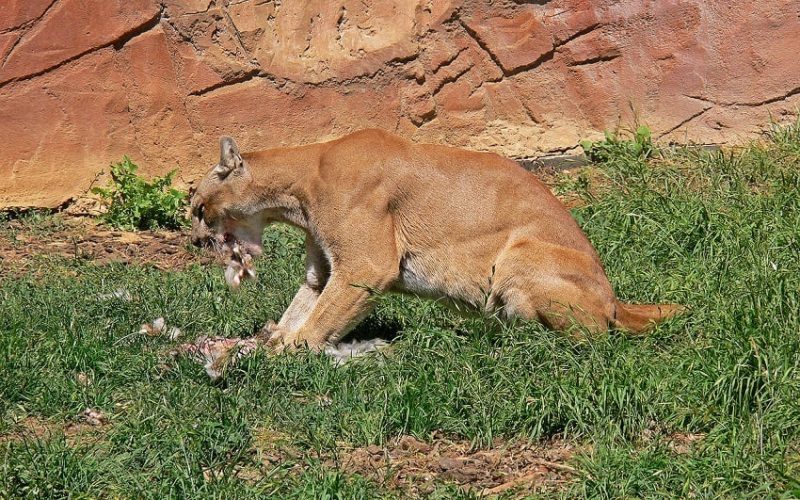
What do mountain lions eat?
If there were mountain lions in Kentucky, they would prey on white-tailed deer, elk, coyotes, raccoons, rabbits, birds such as wild turkeys, various small rodents, American beavers, porcupines, skunks, snakes, pets, farm animals, feral cats, and any other native wildlife they can catch.
Mountain lion behavior
Mountain lions are solitary animals. It’s a Rarity to see 2 or more together unless during mating or in the case of a female raising young. They have expansive home territories.
An adult male’s home range is normally more than 100 square miles and up to 250 square miles. They sometimes mark their territory by leaving claw marks on trees. They also scratch up piles of leaves and or pine needles that they urinate on as scent markers. Male mountain lions fight to the death sometimes to defend their territory.
Are there black panthers in Kentucky?
From time to time, there are reports of black panthers in Kentucky, especially in western Kentucky. Are they out there?
Here’s a quote from John Hast, who is the Kentucky Department of Fish and Wildlife’s bear and furbearer coordinator, which appeared in the Hancock Clarion. “We do not have any black feline species in Kentucky, A black panther is a South American, Amazonian Jungle kind of deal…In addition, the climate of Kentucky, specifically the winters, does not allow black panthers to survive here…As a breeding population, Cougars are considered extinct in the state…”
What we call black panthers are actually melanistic leopards or jaguars. Leopards live in Africa and Asia, while jaguars live on all three American continents. In recent years, the closest to Kentucky that they have been seen is the desert southwestern United States. See
If there are Jaguars in the southwestern United States, although the chances are very slim, it isn’t 100% impossible that a black one might be wandering around in Kentucky. It isn’t probable, but it is possible.
Recent Posts
The only venomous snakes in Washington State are Northern Pacific Rattlesnakes. The Northern Pacific Rattlesnake (Crotalus oreganus oreganus) is a sub-species of the Western Rattlesnake. Anyone...
Skunks are not classified as true hibernators. But they go into a state of torpor when the weather gets cold. Skunks are light sleep hibernators, along with opossums, bears, and raccoons. ...

